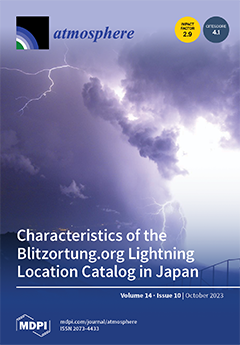This study presents the characterization and source apportionment of water-soluble inorganic ions (WSII), contained in particulate matter with an aerodynamic diameter equal to or less than 2.5 μm (PM
2.5), performed using the positive matrix factorization model (PMF). PM
2.5 were collected in Mexico City from two sites: at Merced (MER), which is a residential location with commercial activities, and at Metropolitan Autonomous University (UAM), which is located in an industrial area. The monitoring campaign was carried out across three seasons named Hot Dry (HD) (March–June), Rain (RA) (July–October), and Cold Dry (CD) (November-February). PM
2.5 concentration behavior in both sites was similar, following the order: CD > HD > RA. The UAM site exhibited higher concentrations of PM
2.5, of the five cations (Na
+, Mg
2+, Ca
2+, K
+ and NH
4+), and of the four anions (Cl
−, SO
42−, NO
3− and PO
43−) than MER, since the UAM site is surrounded by several industrial zones. PM
2.5 average concentrations for UAM and MER were 28.4 ± 11.2 and 20.7 ± 8.4 μg m
−3, respectively. The ratio of cation equivalent to anion equivalent (CE/AC) showed that aerosol pH is acidic, which was confirmed by direct pH measurements. The sulfur oxidation rate (SOR) was 20 times larger than the nitrogen oxidation rate (NOR). Additionally, SO
42− was the most abundant ion during the whole year, especially during the CD season with 5.13 ± 2.5 μg m
−3 and 4.9 ± 3.6 μg m
−3 for UAM and MER, respectively, when solar radiation displayed a high intensity. On the opposite side, the conversion of NO
2 to NO
3−, respectively, was low. The air mass backward trajectories were modeled using the National Oceanic and Atmospheric Administration (NOAA-HYSPLIT), which allowed us to know that differences in the mass trajectories during the days with higher concentrations were due to an effect of air recirculation, which favored PM
2.5 accumulation and resuspension. On the other hand, on the days with less PM
2.5, good air dispersion was observed. The main sources identified with the PMF model were secondary aerosol, vehicular, industrial crustal, and biomass burning for UAM, while for MER they were vehicular, secondary aerosol, and crustal.
Full article





